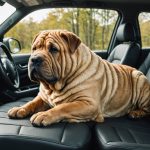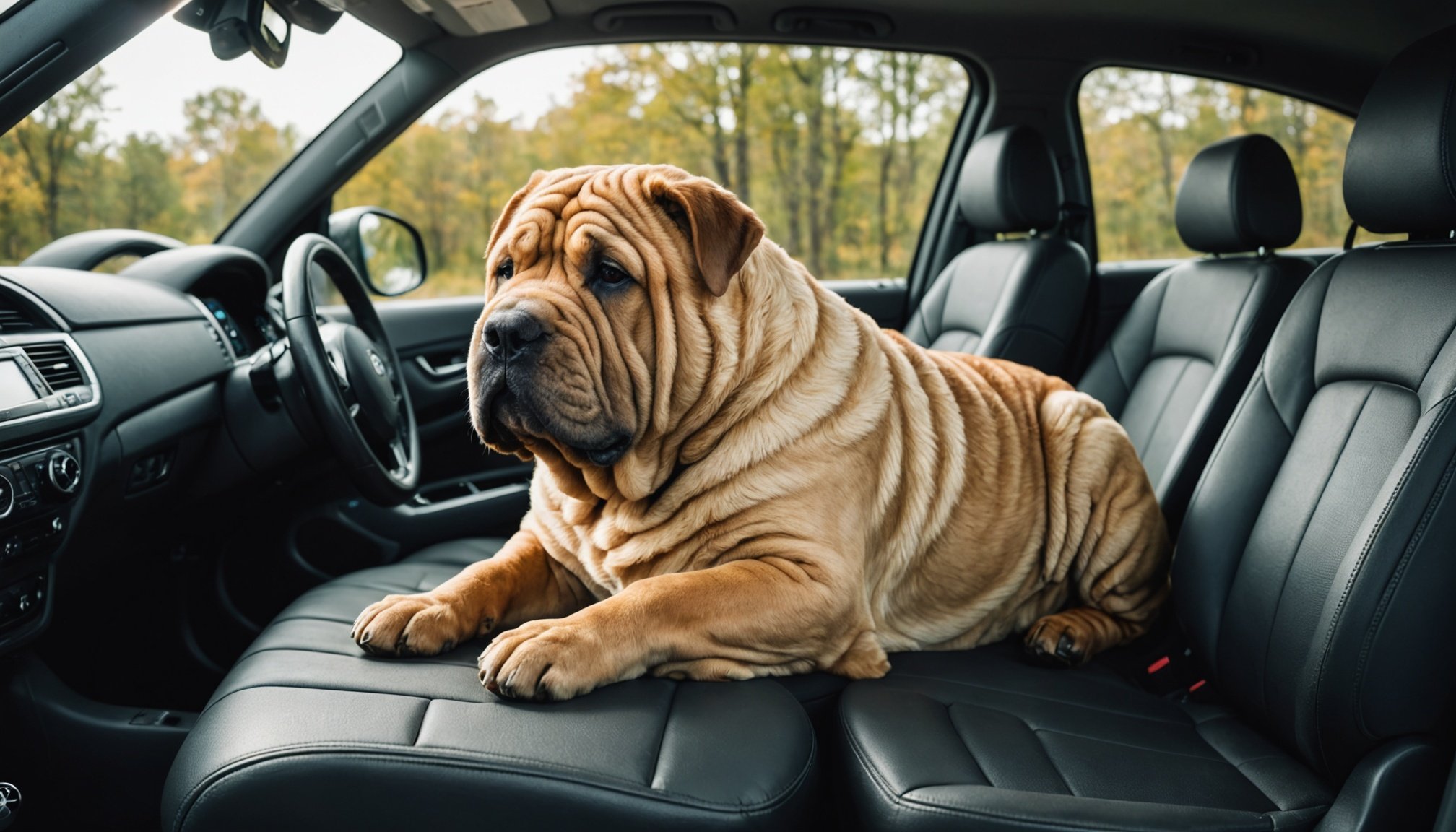Understanding Shar Pei Anxiety During Car Travel
Travelling with your Shar Pei? Understanding dog travel anxiety, especially in Shar Peis, is crucial for a peaceful journey. Pet anxiety in cars stems from numerous factors. Common causes include discomfort from motion, unpleasant past experiences, or lack of exposure to car travel.
Recognising signs of Shar Pei anxiety during car rides can help alleviate stress. Watch for behaviours such as excessive drooling, panting, restlessness, or whining. In some cases, your Shar Pei might become visibly agitated, pacing or displaying refusal to enter the vehicle.
Have you seen this : Spotting initial seizure alerts in epileptic border collies: crucial tips for pet owners to prepare
Each dog’s anxiety triggers differ, making it essential to pay attention to your pet’s specific responses. Some dogs may react more to visual stimuli like moving objects, while others might be troubled by the car’s sounds or vibrations. Understanding these individual triggers is vital to tailor strategies that address the root of your pet’s anxiety.
By knowing what to look for and understanding what triggers unease in your Shar Pei, you can start to implement calming techniques. This could include gradual exposure to car travel or creating a more familiar, comfortable environment within the vehicle.
Also read : Spotting dental issues in miniature schnauzers: essential signs and proven prevention strategies
Preparing Your Shar Pei for Car Travel
Car travel preparation for dogs requires patience and consistency. To start, using desensitizing techniques is key to easing your Shar Pei into a calm state when nearing a vehicle. Gradually introduce them to the car environment by allowing your Shar Pei to explore it when it’s stationary.
Start with short periods inside the car to make them comfortable. Once they’re settled, you can move on to car travel training by introducing the sounds and movements associated with driving. Initially, turn on the engine while your Shar Pei remains in their safe space within the car.
Use positive reinforcement techniques to encourage good behaviour. Bring along their favourite treats or toy to create a positive association with being in the car. During short trips, reward them frequently to boost their confidence and create a pleasant experience.
Remember, a gradual desensitization will help your dog remain composed during longer journeys. For dogs who appear anxious, take breaks and return to the previous step of the process, rewarding them generously for their calmness.
Appropriate Travel Gear for Anxiety Relief
Travelling with pets can be stressful, highlighting the importance of using the right dog travel gear. The proper equipment ensures not only their safety but also mitigates travel-induced anxiety. Let’s delve into the critical options available.
Harnesses and Seatbelts
Harnesses and seatbelts provide significant benefits as safety restraints, keeping dogs secure and reducing the risk of injury during sudden stops. These devices significantly contribute to a dog’s well-being in moving vehicles. They also play a crucial role in minimising anxiety, allowing dogs to feel balanced and secure. When selecting a dog seatbelt, choose one with adjustable features and robust materials, ensuring a snug fit and reliability during the journey.
Crates and Carriers
Choosing an appropriate crate is essential for a calming travel experience. A well-ventilated crate with enough space for movement can become a secure zone for your pet. Making the crate a safe haven involves lining it with familiar items like blankets or toys, which can help calm pets during transit.
Anxiety Wraps and Other Calming Aids
Anxiety wraps, like Thundershirts, apply constant pressure, providing a soothing effect. Other calming aids include pheromone sprays and essential oils, offering additional comfort for dogs prone to anxiety. These products can collectively contribute to a stress-free travel experience for your furry companion.
Creating a Comfortable Car Environment
Ensuring a dog-friendly car environment is crucial for both comfort during travel and reducing car stress for your pet. Start by setting up a comfortable and secure space in the car. This can be achieved by using a pet seat cover or hammock, which not only provides a designated area for your dog but also helps contain fur and mess.
Next, consider managing the temperature and noise levels to enhance your pet’s comfort. A well-ventilated car with climate control can make a significant difference. Use sunshades on windows to protect from direct sunlight and keep the environment cool. Turn down the music, or use noise-cancelling devices, to shield your dog from excessive noise, which can be unsettling.
To provide emotional support, bring along your dog’s favorite toys or blankets. These familiar items offer a sense of home and security, alleviating anxiety during travel. Remember to secure all items to prevent them from becoming potential hazards in case of sudden stops or turns.
By creating a thoughtful and prepared environment, you contribute to a more enjoyable and stress-free journey for your furry friend.
Additional Tips for Reducing Anxiety
When it comes to managing dog anxiety during travel, a mix of preparation and expert insight proves essential. Integrating practical tips for dog anxiety into your routine beforehand can make a significant difference.
One effective strategy is to incorporate training exercises prior to trips. Familiarizing your dog with travel scenarios reduces uncertainties that lead to anxiety. For example, short car rides can habituate them to the sensation and sounds they might encounter on longer journeys.
Adjusting travel times and routes can also alleviate stress. Try to travel during periods your dog is naturally calm, such as after meals or playtime. Opt for quiet streets rather than busy highways when possible, as the reduced noise and fewer stimuli can help keep their nervousness in check.
Seeking expert advice on dog travel from veterinarians can provide you with tailored calming strategies. Veterinarians might recommend specific calming sprays or supplements suitable for your dog’s needs. They may also offer insights on behaviours that signal anxiety, ensuring early intervention and comfort.
By adopting these travel behaviour strategies, you can enhance your dog’s travel experience while fostering a more relaxed atmosphere for both of you.
Safety Considerations During Car Travel
When it comes to pet safety in cars, the risks of travelling with unrestrained pets are often underestimated. Dogs, like any other unsecured object in a vehicle, can become dangerous projectiles during sudden stops or collisions. This not only endangers the pet but also poses a risk to all passengers.
To enhance travel safety for dogs, it’s essential to employ proper restraints such as seat belt harnesses or pet carriers securely strapped in place. These ensure that your dog remains safe and minimises distractions for the driver, contributing to a safer journey for everyone involved.
Additionally, frequent breaks are crucial to maintain the well-being of your furry friend. Dogs need opportunities to stretch, hydrate, and relieve themselves during long travels. Travel safety tips for dogs include planning stops every 2-3 hours to meet these needs, making the journey more comfortable for both your dog and you.
In unforeseen situations where a pet might panic, causing distress in the car, remaining calm is key. Emergency preparedness means having a plan, such as pulling over safely to offer reassurance or having a familiar item to soothe your pet. This underscores the importance of understanding and adhering to dog car safety rules to ensure a pleasant travel experience.
Supporting Your Shar Pei Post-Travel
Returning from a trip with your Shar Pei requires thoughtful post-travel pet care to ease their transition back to home life. Maintaining a consistent routine is crucial, as travel can disrupt their familiar environment, causing anxiety. Try to re-establish feeding, walking, and playtime schedules promptly to provide a sense of stability.
Recognizing signs of lingering anxiety is vital. Symptoms may include restlessness, excessive barking, or withdrawing from interaction. These behaviours might indicate your Shar Pei is struggling with the change. Managing after travel anxiety involves patience and attentiveness.
To aid recovery for anxious dogs, consider implementing calming techniques. These can range from providing a quiet space to using familiar toys or blankets that carry comforting scents. Additionally, spending extra quality time with your pet, such as engaging in light play or offering gentle petting, can create reassurance.
For more persistent anxiety, consider consulting a veterinarian or a pet behaviour specialist. They can offer further insights or potential recovery strategies tailored to your dog’s specific needs. Ultimately, understanding and addressing your Shar Pei’s unique post-travel stresses ensures a smoother adjustment and happier homecoming.











